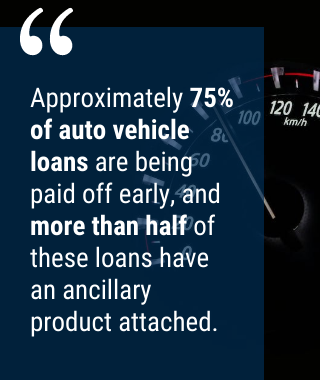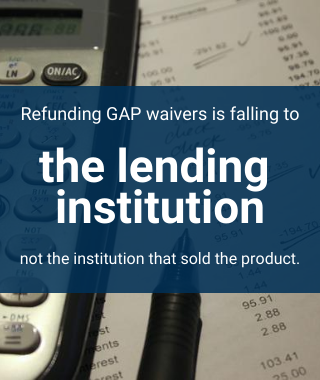What Your Credit Union Needs to Know About GAP Waivers in 2022
By Gregory Rucker, Second Vice President of Claim & Recovery Business Solutions | Allied Solutions
Guaranteed Asset Protection (GAP) is attractive to members as a vehicle protection product. But what happens after the product is sold? Credit unions are grappling with the growing legislation around the life cycle - particularly the cancellation - of this product.
 GAP Waivers and Early Loan Payoffs
GAP Waivers and Early Loan Payoffs
According to Experian, the 2022 average loan term is 69.48 months for new vehicles and 67.65 months for used vehicles. With loan terms trending longer it is not uncommon for members to pay off loans early to save money on monthly expenses and interest payments, and to lower their debt-to-income ratio. In fact, approximately 75% of auto vehicle loans are being paid off early, and more than half of these loans have an ancillary product, like GAP, attached.[1] Ancillary products usually carry prorated provisions in the event of an early loan payoff. When a loan with a GAP waiver is paid off early, the member may be due a refund for the unused, or unearned, portion of the product.
Litigation is Bubbling Up
Increased litigation in many states, along with amplified attention from the CFPB, is holding credit unions liable to ensure that members are receiving these refunds on GAP waivers when a loan is paid off early. These are not small dollar amount refunds either. Three Colorado-based credit unions recently settled litigation and paid out more than $6 million in refunds to members who had canceled GAP waivers.
While credit unions are being required to accept this responsibility, what this looks like varies state-to-state. Each state has different requirements for refunding the member and there is confusion on the measures for calculating the refund amount, only adding to the complexity of this process. This causes several blind spots for refunding GAP waivers, so if your credit union feels underprepared for this process, you are not alone.
Common Compliance Blind Spots for Refunding GAP Waivers
Litigation and its repercussions are catching credit unions off guard. Knowing the blind spots for refunding GAP waivers will help credit unions maintain compliance and proactively execute oversight processes. Here are some common blind spots:
- Blind Spot #1: Product refunds don’t apply to indirect loans. Many credit unions fall under the assumption that if they did not sell the GAP product that they are not responsible for this process. However, as litigation continues to unfold, this is becoming untrue. Refunding GAP waivers is falling to the lending institution, not the institution that sold the product.
 Blind Spot #2: Dealers will determine the refund amount. In most cases, the member purchases GAP through the dealer. When the product is canceled due to early loan payoff, the dealer is often unaware and may not prioritize refunding your member. This puts your credit union at risk for your member not receiving their refund within the timeline that your state requires. Historically, it was acceptable to rely on dealers to initiate the process, determine the refund amount, and deliver the refund to the member, but this is becoming both risky and time-consuming.
Blind Spot #2: Dealers will determine the refund amount. In most cases, the member purchases GAP through the dealer. When the product is canceled due to early loan payoff, the dealer is often unaware and may not prioritize refunding your member. This puts your credit union at risk for your member not receiving their refund within the timeline that your state requires. Historically, it was acceptable to rely on dealers to initiate the process, determine the refund amount, and deliver the refund to the member, but this is becoming both risky and time-consuming. - Blind Spot #3: Credit unions can manage just part of the GAP refund process. An ideal first step for credit unions is to accept the responsibility for refunding canceled GAP waivers. It can’t stop here though. Credit unions can no longer manage 25%, 50%, or even 75% of the refund process. Unless a credit union manages 100% of the process, start to finish, there is potential for litigation and breach of compliance. To remain compliant and proactive, credit unions need a holistic, cradle-to-grave approach to see the refund through from cancellation to calculation to delivery to the member.
Checklist for Removing Compliance Blind Spots
It is critical for credit unions to remain educated on the growing need for a refund management process for canceled GAP waivers. Clear the compliance blind spots with these action items:
- Develop a game plan to stay ahead of the litigation. Even if your credit union operates in a state with reduced regulations surrounding the refund of GAP waivers, it’s best to maintain a proactive approach, should the regulations change.
- Calculate accurate refund amounts. Accurately determining the dollar amount of the refund is highly complex but critical for ensuring that your member receives an accurate refund. This step can also help your credit union avoid UDAAP (unfair, deceptive, or abusive acts and practices) violations.
- Enhance dealer relationships. Credit unions have been long known for their emphasis on community and relationship building. This value is just as important for dealership relationships, but isn’t without some added challenges. By alleviating dealers from initiating and overseeing the refund process, credit unions can enhance these relationships while remaining compliant.
- Don’t go this alone. While it is best practice to oversee the GAP refund process, there are still many complexities that are burdensome for credit unions. For experienced guidance, find and select a provider that supports the sale of the GAP product as well as the product refunds. This isn’t a conflict of interest. It provides a clear line of sight from the GAP claim to the final refund, increasing efficiencies.
Knowing that these blind spots exist can help credit unions overcome them with strategic efforts. When your credit union accepts the responsibility for managing product refunds, compliance is amplified, members don’t have to track down refunds, and dealer relationships are enhanced. Now is the time to probe your risk management program and include product refunds in your blueprint.
Stay tuned for part two of this blog series, focusing on the dos and don’ts credit unions need to be aware of for product refunds.
Allied Solutions is proud to be NAFCU’s Preferred Partners for Guaranteed Asset Protection (GAP) and Product Refund Liability (RefundPlus(R))
